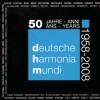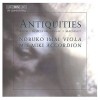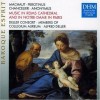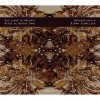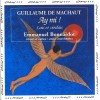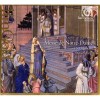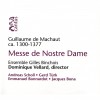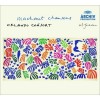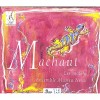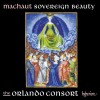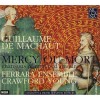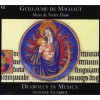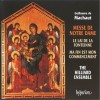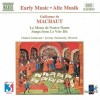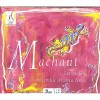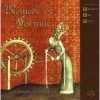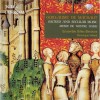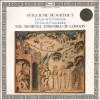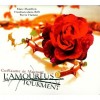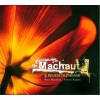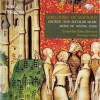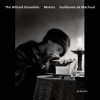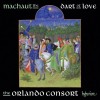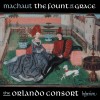| Country: | France |
| Period: | Middle Ages |
Biography
Guillaume de Machaut (sometimes spelled Machault) (c. 1300 – April 1377) was a Medieval French poet and composer. He is one of the earliest composers on whom significant biographical information is available. According to Daniel Leech-Wilkinson, Machaut was "the last great poet who was also a composer". Well into the 15th century, Machaut's poetry was greatly admired and imitated by other poets, including Geoffrey Chaucer.
Machaut composed in a wide range of styles and forms. He is a part of the musical movement known as the ars nova. Machaut helped develop the motet and secular song forms (particularly the lai and the formes fixes: rondeau, virelai and ballade). Machaut wrote the Messe de Nostre Dame, the earliest known complete setting of the Ordinary of the Mass attributable to a single composer.
Guillaume de Machaut was born c. 1300 and educated in the region around Rheims. Though his surname most likely derives from the nearby town of Machault, 30 km east of Rheims in the Ardennes region, most scholars believe his birthplace was, in fact, Rheims.
He was employed as secretary to John I, Count of Luxemburg and King of Bohemia, from 1323 to 1346 and also became a canon (1337). He most likely accompanied King John on his various trips, many of them military expeditions, around Europe (including Prague). He was named the canon of Verdun in 1330, Arras in 1332, and Rheims in 1337. By 1340, Machaut was living in Rheims, having relinquished his other canonic posts at the request of Pope Benedict XII. In 1346, King John was killed fighting at the Battle of Crécy, and Machaut, who was famous and much in demand, entered the service of various other aristocrats and rulers, including King John's daughter Bonne (who died of the Black Death in 1349), her sons Jean de Berry and Charles (later Charles V, Duke of Normandy), and others such as Charles II of Navarre.
Machaut survived the Black Death that devastated Europe and spent his later years living in Rheims composing and supervising the creation of his complete-works manuscripts. His poem Le voir dit (probably 1361–1365) purports to recount a late love affair with a 19-year-old girl, Péronne d'Armentières, although the accuracy of the work as autobiography is contested. When he died in 1377, other composers such as François Andrieu wrote elegies lamenting his death.
Guillaume de Machaut's lyric output comprises around 400 poems, including 235 ballades, 76 rondeaux, 39 virelais, 24 lais, 10 complaintes, and 7 chansons royales, and Machaut did much to perfect and codify these fixed forms. Some of his lyric output is inserted in his narrative poems or "dits", such as Le remède de fortune ("The Cure of Ill Fortune") which includes one of each genre of lyric poetry, and Le voir dit ("A True Story"), but most are included in a separate, unordered section entitled Les loanges des dames. That the majority of his lyrics are not set to music (in manuscripts, music and non-music sections are separate) suggests that he normally wrote the text before setting some to music.
Other than his Latin motets of a religious nature and some poems invoking the horrors of war and captivity, the vast majority of Machaut's lyric poems partake of the conventions of courtly love and involve statements of service to a lady and the poet's pleasure and pains. In technical terms, Machaut was a master of elaborate rhyme schemes, and this concern makes him a precursor to the Grands Rhétoriqueurs of the 15th century.
Guillaume de Machaut's narrative output is dominated by the "dit" (literally "spoken", i.e. a poem not meant to be sung). These first-person narrative poems (all but one are written in octosyllabic rhymed couplets, like the romance, or "roman" of the same period) follow many of the conventions of the Roman de la rose, including the use of allegorical dreams (songes), allegorical characters, and the situation of the narrator-lover attempting to return toward or satisfy his lady.
Machaut is also responsible for a poetic chronicle the chivalric deeds of Peter I of Cyprus (the Prise d'Alexandrie) and for poetic works of consolation and moral philosophy. His unusual self-reflective usage of himself (as his lyrical persona) as the narrator of his dits gleans some personal philosophical insights as well.
At the end of his life, Machaut wrote a poetic treatise on his craft (his Prologue). This reflects on his conception of the organization of poetry into set genres and rhyme schemes, and the ordering of these genres into distinct sections of manuscripts. This pre-occupation in ordering his oeuvre is reflected in an index to MS A entitled "Vesci l'ordenance que G. de Machau wet qu'il ait en son livre" ("Here is the order that G. de Machaut wants his book to have").
Machaut's poetry had a direct effect on the works of Eustache Deschamps, Jean Froissart, Christine de Pizan, René of Anjou and Geoffrey Chaucer, among many others.
Principal works
Le remède de fortune ("The Cure of Ill Fortune") (c. 1340s, before 1357) – The narrator is asked by his lady if the poem she has found is by him; the narrator flees from her and comes to a garden where "Hope" consoles him and teaches him how to be a good lover; he returns to his lady.
Jugement du roy de Behainge ("Judgement of the King of Bohemia") (before 1346) – The narrator hears a debate between a lady (whose lover is dead) and a knight (betrayed by his lady); in order to proclaim one or the other the most unhappy, the narrator seeks out the advice of the King of Bohemia who consults allegories, and the unhappy knight is declared the winner.
Dit du Lyon ("Story of the Lion") (1342) – The narrator comes to a magical island and a lion guides him to a beautiful lady; an old knight comes to the narrator and reveals the meaning of what he sees and gives him advice for being a better lover.
Dit de l'Alérion aka Dit des quatre oiseaux ("Story of the 4 Birds") (before 1349) – A symbolic tale of love: the narrator raises four different birds, but each one flees him; one day the second (and preferred) bird comes back to him.
Jugement du roy de Navarre ("Judgement of the King of Navarre") (1349) – Following up on the Jugement du roy de Behainge, a lady blames the narrator for awarding the prize to the knight: the King of Navarre is consulted and condemns the poet.
Confort d'ami (1357) - Dedicated to Charles II of Navarre (who was a prisoner in France), this poetic consolation gives biblical and classical examples (exempla) of fortitude.
Dit de la fontaine amoureuse aka Livre de Morpheus ("Story of the Amorous Fountain") (1361) – The narrator meets a hopeless lover who must separate from his lady; the two men come to a magical fountain and fall asleep, and in a dream the lady consoles her lover.
Le voir dit ("A True Story") (c. 1362–65) – Often seen as Machaut's masterpiece, this poem is an early example of meta-fiction and tells of the sadness and separation of the narrator, from his lady and of the false rumors that are spread about him. The narrative is stuffed with prose letters and lyric poems that the narrator claims were in truth exchanged by the unhappy lovers and put in the book at the behest of his lady. The work however is highly satirical and mocks the conventional paradigm of medieval courtly literature by presenting himself as an old, ill, impotent poet as the lover of a young and beautiful maiden, who falls in love with him from his reputation as a poet alone. Though the work is called a voir dit or true story, Machaut includes many inconsistencies which force the reader to question the truthfulness of his story.
Prologue (c. 1372) – written at the end of his life as a preface to his collected works, this allegory describes Machaut's principles of poetry, music and rhetoric, as imparted to him by Nature and Love.
Prise d'Alexandrie ("The Capture of Alexandria") (after 1369) – poetic retelling of the exploits of Peter of Lusignan, King of Jerusalem and of Cyprus.
As a composer of the 14th century, Machaut's secular song output includes monophonic lais and virelais, which continue, in updated forms, some of the tradition of the troubadours. He also worked in the polyphonic forms of the ballade and rondeau and wrote the first complete setting of the Ordinary of the Mass which can be attributed to a single composer. Machaut fused together contemporary styles and techniques to create a series of masterworks that Classic FM Magazine says stands at the summit of 14th century music.
Secular music
The lyrics of Machaut's works almost always dealt with courtly love. A few works exist to commemorate a particular event, such as M18, "Bone Pastor/Bone Pastor/Bone Pastor." Machaut mostly composed in five genres: the lai, the virelai, the motet, the ballade, and the rondeau. In these genres, Machaut retained the basic formes fixes but often utilized creative text setting and cadences. For example, most rondeaux phrases end with a long melisma on the penultimate syllable. However, a few of Machaut's rondeaux, such as R18 "Puis qu'en oubli", are mostly syllabic in treatment.
Machaut's motets often contain sacred texts in the tenor, such as in M12 "Corde mesto cantando/Helas! pour quoy virent/Libera me". The top two voices in these three-part compositions, in contrast, sing secular French texts, creating interesting concordances between the sacred and secular. In his other genres, though, he does not utilize sacred texts.
Sacred music
Machaut's cyclic setting of the Mass, the Messe de Nostre Dame ("Mass of Our Lady"), was probably composed for Rheims Cathedral in the early 1360s. While not the first cyclic mass – the Tournai Mass is earlier – it was the first by a single composer and conceived as a unit. Machaut probably was familiar with the Tournai Mass since the Messe de Nostre Dame shares many stylistic features with it, including textless interludes.
Whether or not Machaut's mass is indeed cyclic is contested; after lengthy debate, musicologists are still deeply divided. However, there is a consensus that this mass is at best a forerunner to the later 15th-century cyclic masses by the likes of Josquin des Prez. Machaut's mass differs from these in the following ways: (1) he does not hold a tonal centre throughout the entire work, as the mass uses two distinct modes (one for the Kyrie, Gloria and Credo, another for Sanctus, Agnus and Ita missa est); (2) there is no extended melodic theme that clearly runs through all the movements, and the mass does not use the parody technique; (3) there is considerable evidence that this mass was not composed in one creative motion. That the movements may have been placed together does not mean they were conceived so.[5]
Nevertheless, the mass can be said to be stylistically consistent, and certainly the chosen chants are all celebrations of Mary, the mother of Jesus. Also adding weight to the claim that the mass is cyclic is the possibility that the piece was written or assembled for performance at a specific celebration. The possibility that it was for the coronation of Charles V, which was once widely accepted, is thought unlikely in modern scholarship. The composer's intention that the piece be performed as one entire mass setting makes the Messe de Nostre Dame generally considered a cyclic composition.







